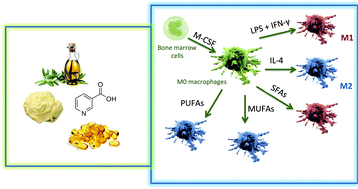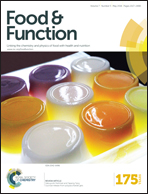Niacin and olive oil promote skewing to the M2 phenotype in bone marrow-derived macrophages of mice with metabolic syndrome†
Abstract
Metabolic syndrome (MetS) is associated with obesity, dyslipemia, type 2 diabetes and chronic low-grade inflammation. The aim of this study was to determine the role of high-fat low-cholesterol diets (HFLCDs) rich in SFAs (HFLCD-SFAs), MUFAs (HFLCD-MUFAs) or MUFAs plus omega-3 long-chain PUFAs (HFLCD-PUFAs) on polarisation and inflammatory potential in bone marrow-derived macrophages (BMDMs) from niacin (NA)-treated Lepob/obLDLR−/− mice. Animals fed with HFLCD-SFAs had increased weight and serum triglycerides, and their BMDMs accumulated triglycerides over the animals fed with HFLCD-MUFAs or -PUFAs. Furthermore, BMDMs from animals fed with HFLCD-SFAs were polarised towards the M1 phenotype with functional competence to produce pro-inflammatory cytokines, whereas BMDMs from animals fed with HFLCD-MUFAs or -PUFAs were skewed to the anti-inflammatory M2 phenotype. These findings open opportunities for developing novel nutritional strategies with olive oil as the most important dietary source of MUFAs (notably oleic acid) to prevent development and progression of metabolic complications in the NA-treated MetS.


 Please wait while we load your content...
Please wait while we load your content...